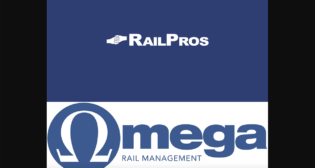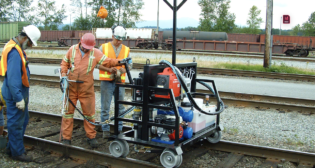
Highway homicide affects railroads, too
Written by Frank N. Wilner, Capitol Hill Contributing EditorThis is about a highway homicide — and we know who dunnit. The perp long ago was identified by state and federal authorities. Yet Congress refuses to order the collar, closing its eyes to a mayhem playing out at every hour, on every federal-aid roadway and adversely affecting every taxpayer and every motorist in the wallet, while simultaneously turning on its head the concept of economic efficiency.
 Beyond a shadow of doubt is that heavy trucks pummel pavements and weaken highway bridges, shortening the lives of each while avoiding payment for the damage caused. That’s highway homicide.
Beyond a shadow of doubt is that heavy trucks pummel pavements and weaken highway bridges, shortening the lives of each while avoiding payment for the damage caused. That’s highway homicide.
The American Association of State Highway and Transportation Officials (AASHTO) concluded — in a 49-state funded study validated by separate, independent testing in Canada — that as axle weights double, pavement damage increases by 16-fold. It means, according to the U.S. General Accountability Office, that one 80,000-pound truck causes the equivalent infrastructure damage as 9,600 automobiles, yet heavy trucks pay highway user charges well below their cost responsibility. That’s economic nonsense on top of highway homicide because it is bankrupting the Highway Trust Fund that was created to ensure users pay the costs of federal-aid highway construction and reconstruction.
The trucking industry’s failure to pay its way when traveling user-financed federal-aid highways has drained the Highway Trust Fund and cost general taxpayers — who have had to bail it out — more than $40 billion since 2008 for highway costs.
Of some 4 million miles of roadway in the United States, some 1 million miles receive federal aid, including the 47,000-mile Interstate Highway System.
Trucking interests favor increasing the federal fuels tax — from 18.4 cents per gallon of gasoline to 33.4 cents; and from 24.4 cents per gallon of diesel fuel to 39.4 cents — to solve the Highway Trust Fund shortfall.
In fact, a per-gallon fuels tax is the least equitable means of matching cost responsibility with payment. Academic and state studies have demonstrated that the more equitable method of user-cost reimbursement is a charge that calculates weight and mileage, as heavy trucks inflict substantial pavement and bridge damage each mile traveled.
A fuels tax creates a transfer (subsidy) from light trucks and automobiles to heavy trucks, such as tractor-trailer combinations, and explains why American Trucking Associations (ATA) President Bill Graves says a fuels tax increase is “absolutely the right position to take,” even though heavy-truck fuel economy is improving while heavy-truck pavement damage remains a significant reason for the Highway Trust Fund shortfall.
The Federal Highway Administration calculated, for example, that 80,000-pound trucks pay only 66% of their direct cost responsibility, with other highway users and general taxpayers funding the shortfall. There also are indirect costs imposed by heavy trucks on other highway users, such repair of front-end damage, more frequent front-end alignments, diminished vehicle fuel efficiency owing to damaged roads, and increased accident exposure.
A trucking official once asserted that weather is the principle culprit for pavement damage, evoking a rebuke from a highway engineer that it doesn’t rain, snow or freeze more in the left lane than the right lane, noting that on four-lane highways, ruts, potholes and washboard effects are most pronounced in the right lane more populated by heavy trucks.
Beyond seeking preservation of the inequitable fuels tax to replenish the Highway Trust Fund, trucking interests also want an increase in nationwide allowable maximum truck weights — from the current 80,000-pound maximum on federal-aid highways to 97,000 pounds — which will create even more pavement pummeling and bridge deterioration, and widen the gap between heavy-truck cost responsibility and payment.
Shifting from a federal fuels tax to one calculated based on weight and mileage can be accomplished with minimal administrative cost using modern electronics, such as transponders and global positioning satellites. In fact, the use of on-board recorders to monitor driver alertness and hours-of-service compliance already has the support of trucking interests.
Failure to charge heavy-trucks their proper cost responsibility also adversely affects economic efficiency. When truckers underpay their highway cost responsibility, they gain an unearned cost advantage, allowing them to price their services lower, which creates a misallocation of freight onto less safe highways from more fuel-efficient and safer railroads.
A recent Gallup Poll indicated opposition to higher fuels taxes, which is understandable given that automobile and light-truck operators already significantly overpay their highway cost responsibility.
Yet transferring even more from the Treasury’s General Fund to the Highway Trust Fund would further shift the appropriate cost burden from big trucks to all taxpayers — even those not using highways. That would stand economic efficiency even more on its head than the current inefficiency of automobile and light truck operators subsidizing big trucks. It also could open the door to an even greater heavy-truck subsidy as truckers surely would support total federal highway aid being paid by general taxpayers rather than direct users.
Economic efficiency and equity demand that users pay in proportion to what they consume — and certainly heavy truck operators have the ability to pay their equitable costs.
A significant number in Congress are fond of quoting 18th century political economist Adam Smith. They should not ignore his counsel on user charges now that the problem of solving the Highway Trust Fund deficit is in their laps and requiring a solution before the till is empty by September. Wrote Smith in his 1776 An Inquiry into the Nature and Causes of the Wealth of Nations:
“When the carriages which pass over a highway or bridge … pay tolls in proportion to their weight or their tonnage, they pay for the maintenance of those public works exactly in proportion to the wear and tear which they occasion of them. It seems scarce possible to invent a more equitable way of maintaining such works.”



